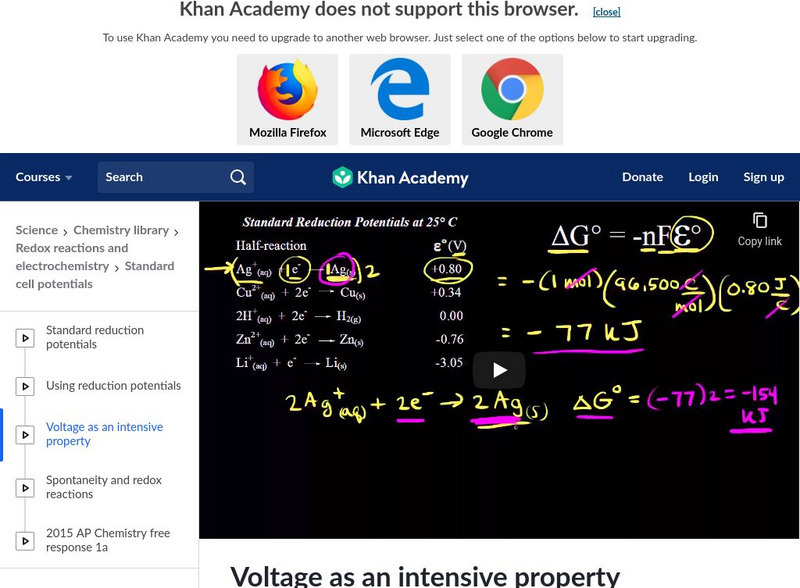Crash Course
Electric Current: Crash Course Physics #28
Explore the basics of electric current with an introductory video lesson. The 28th installment in the Crash Course physics series discusses characteristics of electric current. An explanation of Ohm's Law helps scholars understand the...
Crash Course
Voltage, Electric Energy, and Capacitors: Crash Course Physics #27
Help your classes realize their potential! A thorough lesson on potential electric energy helps scholars understand the basics of voltage and capacitors. The instructor also shows how to calculate electric potential energy in the 27th...
Fuse School
Measures of Electricity
Not all electricity is created equal. A detailed video explains how to measure the strength of electricity using a voltmeter. The 31st installment of the 35-part series uses a demonstration to explain the process of measuring current and...
Fuse School
Electrochemical Series
Viewers may find this lesson quite shocking if they're not careful! A detailed video presentation explains how to read an electrochemical series to predict the direction of a chemical reaction under an electrical circuit.
Educreations
Using the Nernst Equation
Explore the application of the Nernst Equation to calculate a cell voltage. The instructor explains the purpose of the formula and its appropriate application. Using a specific example, he demonstrates the work required when using the...
DoodleScience
Series and Parallel Circuits
Here's a video that explains the difference between series and parallel circuits, including the impacts of each on current and voltage.
DoodleScience
Charge, Current and Voltage
This brief video provides definitions for charge, current, and voltage and compares and contrasts these terms. The video also discusses coulomb, amps, and joules.
DoodleScience
Resistance
Want a quick explanation for how resistance works as an electric current flows through a wire? Then check out this video that covers electrons, conductors, ions, and the formula for resistance. It also graphs how voltage varies...
DoodleScience
Transformers and the National Grid
Understand the science behind the path electricity takes to our homes. The video shows how the role of transformers is important to the efficiency of the system.
TED-Ed
How Batteries Work
Discover the fascinating technology that allows us to move around in our daily lives without being anchored to power cables. Learners trace the history of batteries and their ability to store charge back to the 1780s, and...
Curated OER
How a Capacitor Works
A capacitor stores energy in the form of an electric charge. See a circuit diagram explaining charges and electron flow. Equations are given for energy and a capacitor is made. Show this to your physics or beginning electronics class.
Curated OER
Introduction to Electricity
A sleepy-sounding narrator teaches about moving electrons, accompanied by video and simple computer animations. He explains what a circuit is, what voltage means, and what current and amperes are. Throughout the video, safety tips for...
Curated OER
Electrical Circuits: Voltage
Voltage in relation to electrical circuits is the topic of this clip. First potential energy is explained in terms of gravity, then the idea is conveyed to describe how the chemicals in a battery act as potential energy for an electrical...
Curated OER
Voltage and Current, Part 2
Second in a two-part lesson on electricity, this video explores how voltage sources can be applied to create electron flow in a circuit. Though it is not modern or high-quality, it is educational. Used with part one, it can sufficiently...
Curated OER
Voltage and Current, Part 1
First in a two-part series, this video is comprised of diagrams, pictures, and animated images explaining how an imbalance of electrons causes them to move. Stored electric charge is revealed as potential energy, and a water tower...
Khan Academy
Khan Academy: Circuits: Capacitors and Capacitance
Get an inside look at a capacitor in this video to see how capacitors store charge. Also given is several examples of how to use the formula for capacitance to calculate charge, voltage, and capacitance. [5:42]
Khan Academy
Khan Academy: Voltage as an Intensive Property
A demonstration that voltage is an intensive property by calculating the voltage and change in Gibbs free energy for a half reaction. [5:16]
Khan Academy
Khan Academy: Introduction to Circuits and Ohm's Law
Learn the basics of circuits with this video. Video will define current and resistance to explain how electrons flow to create electricity. [11:39]
PBS
Pbs Kids: Animations: What Is a Series Circuit?
Narrated animation that visually explains how wiring a set of batteries in series increases voltage. (30 secs) Uses Quicktime.
Science for Kids
Science Kids: How to Videos: Lemon Battery
A video demonstration on how to make a lemon battery with a copper penny, galvanized nail coated in zinc, wires, and a lemon. Video shows how to measure the amount of voltage produced by battery using a volt meter. [6:47]
University of Virginia
Uva Virtual Lab: Two Battery Cells
How does the voltage work when two batteries are put together? Find out in these brief video clips.
University of Virginia
Uva Virtual Lab: Three Battery Cells
What voltage occurs when three similarly charged batteries connect? Check out the four brief video clips illustrating the process.
University of Virginia
Uva Virtual Lab: Battery Water Wheel Analogy
Gain understanding of how the charge works in a battery with the illustration of a gerbil.
University of Virginia
Uva Virtual Lab: Three Capacitors (2 Identical)
What happens when multiple capacitors connect to one another? Check out this virtual lab for results.























